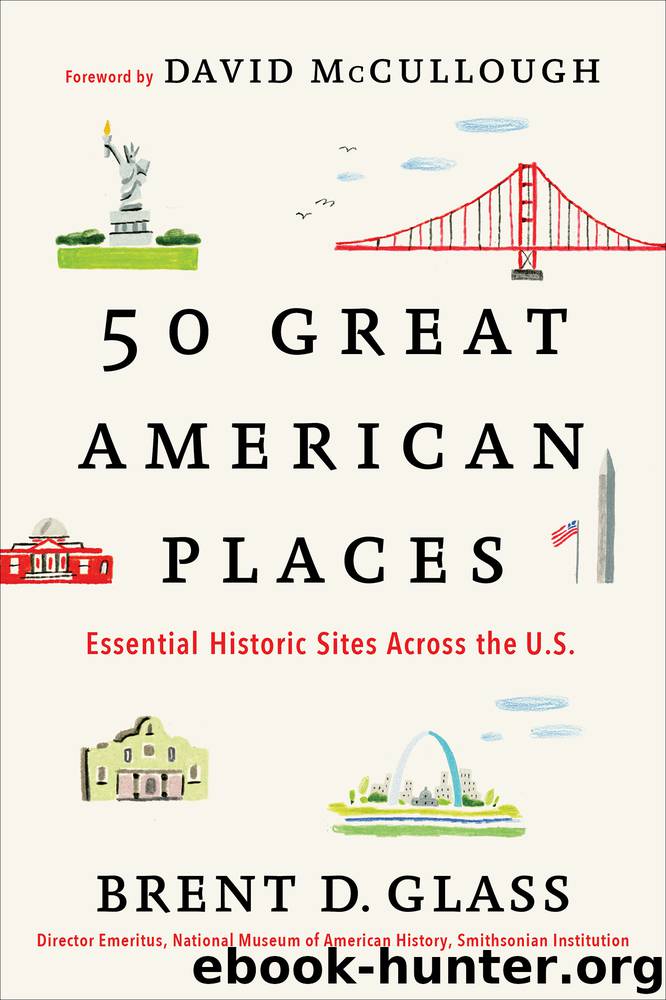50 Great American Places by Brent D. Glass

Author:Brent D. Glass [Glass, Brent D.]
Language: eng
Format: epub
Publisher: Simon & Schuster
Published: 0101-01-01T00:00:00+00:00
31
BILTMORE HOUSE
ASHEVILLE, NORTH CAROLINA
Biltmore House
TIM BUCHMAN
As George Washington Vanderbilt II’s palatial estate rose on a mountaintop overlooking the French Broad River, it instantly became a monument to an era—named “the Gilded Age” by Mark Twain—of fabulous wealth and ostentatious display. More than any single residence in the country, Biltmore House reflected the success and tastes of America’s elite class, what social critic Thorstein Veblen called “conspicuous consumption.” It also reflected its patron’s expansive vision, and was far more ambitious than anything being built by his contemporaries in Manhattan, along the Hudson River, at Newport, Rhode Island, or on Philadelphia’s Main Line.
Vanderbilt was the grandson of Cornelius Vanderbilt, America’s wealthiest man in the nineteenth century. At the time of his death in 1877, Cornelius Vanderbilt left an estate valued at $100 million, and by 1889 the wealth of the Vanderbilt family totaled around $300 million ($7.5 billion in 2010 dollars).
George Vanderbilt was not involved in family businesses. Instead, he spent his inheritance traveling the world, collecting books and art, and building what is still one of America’s largest private dwellings. His selection of a site in North Carolina, far from the wealthy enclaves of the Northeast, came at a time when the South, especially the southern Appalachians, was still recovering from the economic devastation of the Civil War. Biltmore represented a significant change for the region, a rare example of a major financial investment by a Northerner.
Vanderbilt recruited the nation’s most prominent designers to create his estate. Richard Morris Hunt, whose work included Vanderbilt family mansions in New York and Newport, served as senior architect. To design the gardens and park surrounding the mansion, Hunt recruited his friend Frederick Law Olmsted, designer of New York’s Central Park and considered the founding father of landscape architecture in America. From 1889 to 1895, they hired artists, craftsmen, stonemasons, horticulturists, and other specialists along with hundreds of workers who built the mansion and gardens and laid out the farms and woodlands. The massive undertaking required a private railroad to transport supplies, and factories for brickmaking and woodworking.
On Christmas Eve 1895, George Vanderbilt opened Biltmore House to family and friends. What they saw was the most extraordinary house in the country. Olmsted’s three-mile Approach Road created a dramatic entry. Guests arrived at a mansion with a 375-foot-wide façade inspired by the châteaux of France’s Loire Valley. As they wandered through the main floor, they encountered rooms that showcased outstanding craftsmanship and displayed a magnificent collection of art, sculpture, prints, books, and furnishings.
Vanderbilt entertained in a banquet hall with sixteenth-century Flemish tapestries, a triple fireplace with an overmantel carved by Karl Bitter, and an oak dining table with two built-in throne chairs and enough room for 67 dinner guests. He often invited his guests to a library that contained 10,000 books—less than half his overall collection—and a ceiling painting he purchased from a Venetian palace ballroom. The 250-room house covers nearly four acres, including 33 bedrooms, 43 bathrooms, 65 fireplaces, three kitchens, an indoor swimming pool, a bowling alley, and modern conveniences such as elevators and refrigerators.
Download
This site does not store any files on its server. We only index and link to content provided by other sites. Please contact the content providers to delete copyright contents if any and email us, we'll remove relevant links or contents immediately.
What's Done in Darkness by Kayla Perrin(25501)
Shot Through the Heart: DI Grace Fisher 2 by Isabelle Grey(18220)
Shot Through the Heart by Mercy Celeste(18160)
The Fifty Shades Trilogy & Grey by E L James(17777)
The 3rd Cycle of the Betrayed Series Collection: Extremely Controversial Historical Thrillers (Betrayed Series Boxed set) by McCray Carolyn(13190)
The Subtle Art of Not Giving a F*ck by Mark Manson(12916)
Scorched Earth by Nick Kyme(11834)
Stepbrother Stories 2 - 21 Taboo Story Collection (Brother Sister Stepbrother Stepsister Taboo Pseudo Incest Family Virgin Creampie Pregnant Forced Pregnancy Breeding) by Roxi Harding(11041)
Drei Generationen auf dem Jakobsweg by Stein Pia(10218)
Suna by Ziefle Pia(10186)
Scythe by Neal Shusterman(9265)
International Relations from the Global South; Worlds of Difference; First Edition by Arlene B. Tickner & Karen Smith(8614)
Successful Proposal Strategies for Small Businesses: Using Knowledge Management ot Win Govenment, Private Sector, and International Contracts 3rd Edition by Robert Frey(8419)
This is Going to Hurt by Adam Kay(7699)
Dirty Filthy Fix: A Fixed Trilogy Novella by Laurelin Paige(6454)
He Loves Me...KNOT by RC Boldt(5805)
How to Make Love to a Negro Without Getting Tired by Dany LaFerrière(5378)
Interdimensional Brothel by F4U(5305)
Thankful For Her by Alexa Riley(5164)
